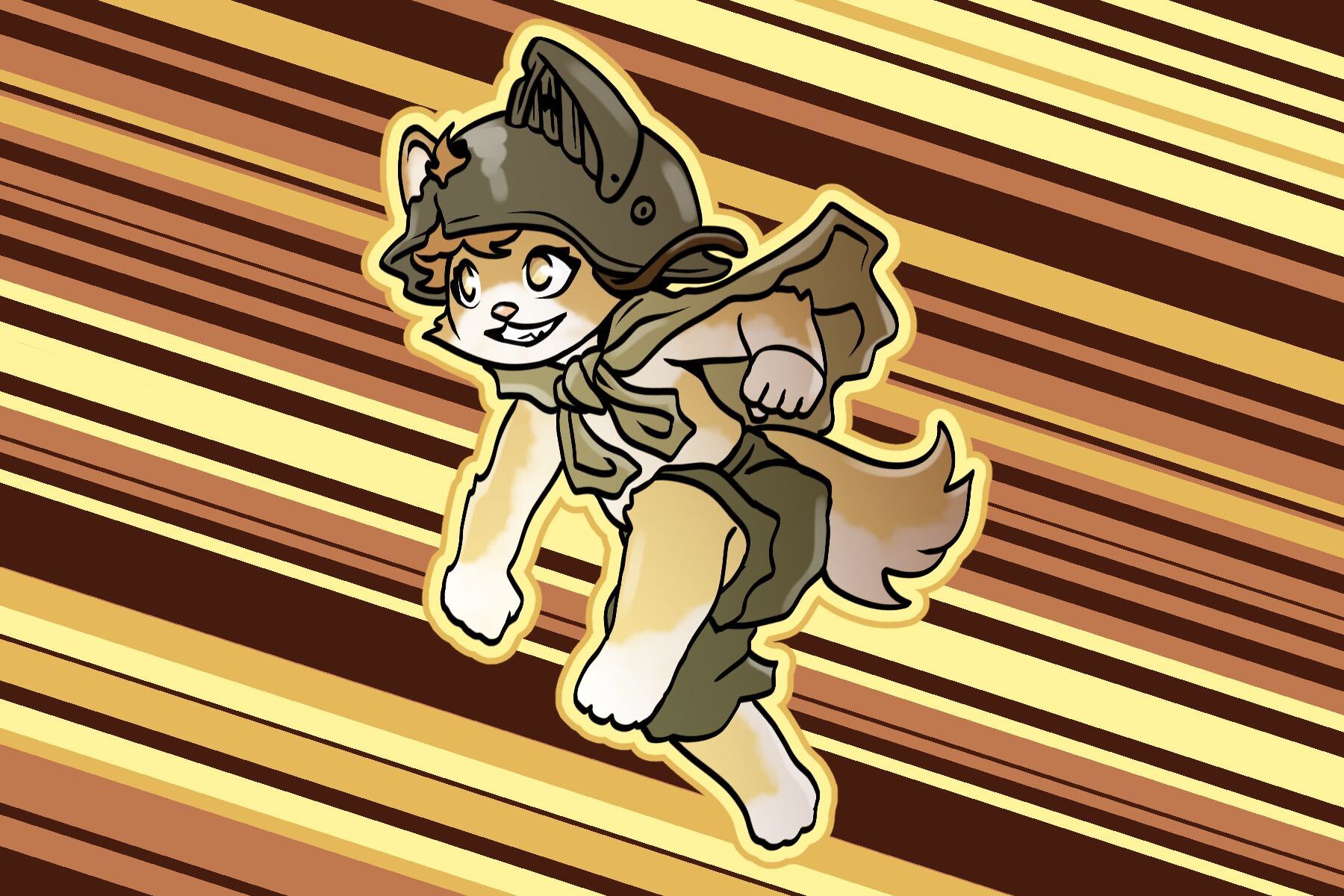Mostly known for their anime-based fighting games and “.hack” series, the Japanese video game studio CyberConnect2 got off the ground in 1998 with a little game called Tail Concerto. Taking place in a world filled with anthropomorphic dogs and cats, referred to as “Caninu” and “Felineko” in the game, Tail Concerto told the story of a dog police officer fighting against a pirate gang. Over a decade later, in 2010, this game would be followed by Solatorobo: Red the Hunter, which is about a dog adventurer who discovers the hidden secrets of his world. These two games serve to build up CyberConnet2’s Little Tail Bronx series.
Back in 2018, CyberConnect2 announced their Next Plan through their website, in which they would publish original games solely under their banner. One of these games, named Fuga: Melodies of Steel, would serve as the third entry in the Little Tail Bronx series. The game was eventually released in July 2021, the year marking CyberConnect2’s 25th anniversary.
What is Fuga: Melodies of Steel, exactly? A prequel taking place over 700 years before the events of Tail Concerto and Solatorobo, Fuga is a turn-based JRPG taking place in a world ravaged by war. The Free Lands of Gasco, in which most of the game takes place, have been under attack from the armies of the fascist Berman Empire. Caught in the middle of this conflict are 12 young children whose parents and friends have been captured and imprisoned by the Berman Army. To save them, the children climb aboard the Taranis, a massive armored tank, to face the Berman Army and rescue their loved ones.
If you appreciate “kemono” culture, you won’t be disappointed here. In case you don’t know, “kemono” culture is essentially what furry culture is in the States, just with a Japanese twist. Much like all other games in the Little Tail Bronx series, Fuga follows this kemono style to a tee. All of the children are depicted as little Caninu and Felineko, so adorable you might forget this game involves war and death.
Fuga is split into 12 different chapters. Each one has the Taranis roll through one landscape after another, facing off against Berman war machines or collecting resources such as health and repair materials. The voyage of the tank is denoted by a route at the top of your screen with symbols indicating what you’ll encounter next: Bermans, Intermissions, Ruins, Health/Materials, and so on. This route will occasionally branch, allowing you to choose an alternate route. These routes range from safe to dangerous, and thankfully the game notifies you of this. Most chapters begin peacefully, with the children bartering goods in a small town. All of them end with a boss fight that tests your skills. Finishing chapters rewards you with progress through the game and End Cards featuring all the children, each lovingly depicted by different artists.
Thirsty for some combat? This game will surely quench it. In battles, you can select three of the 12 children to man the Taranis’ weaponry while the rest serve as backup. There are three weapons in total — machine guns, grenade launchers and cannons — but they can only be used depending on which child you select, so build your trios wisely. (You can always mix them up if the situation calls for it, but only after three runs.) It should also be noted that, while machine guns are the weakest, they have the highest accuracy. Conversely, cannons are the strongest but have the lowest accuracy. Grenade launchers are perfectly neutral.
When a battle begins, the screen will split in half, with the Taranis on the left and the Bermans on the right. At the top of the screen, a timeline will appear with icons of the children on top and Bermans at the bottom. Whenever a child’s icon reaches the end of the timeline, that means it’s time to attack. But be careful: When a Berman icon reaches the end, they will also attack. As you can see who will strike next on the timeline, you can plot your maneuvers beforehand. Delaying Berman attacks can also grant you extra attacks. If you wish to do this, first look underneath their health bar(s). You should see up to three stopwatches whose colors match the colors of your weapons: blue, red and yellow. Striking a Berman with the correct weapon will destroy these stopwatches, and destroying them all results in a delay, giving you more opportunities to plot and strike.
Sometimes, a child can use a special skill to aid them in battle. For example, one child can use the machine gun to deplete an enemy tank’s armor durability, while another can heal the Taranis with a lullaby (yes, really). To learn such skills, all you must do is continue battling your enemies. With the grenade launcher, special bombs can be thrown at the Bermans to give them debuff effects. For example, a Stun Bomb will temporarily cripple a Berman tank’s weaponry, while Smoke will lower their accuracy. You can barter for or find these bombs during your voyage.
Usually, the child manning the gun is accompanied by another for support. If this is the case, you may be able to use a Link Attack, should you exact enough damage to the Bermans. Link Attacks are possible once the relationship between these two children grows strong enough (which you’ll learn more about in the next paragraph), and the duo can be quite devastating. On the other hand, a child may sometimes enter Hero Mode, which gives them strong buff effects for five turns.
As this is a game about war, it’s inevitable that the children will ultimately face the emotional and physical consequences of their actions. Berman attacks can render a child depressed, fearful, injured, or even unconscious (this game is kind enough to spare them death, at least while fighting regularly). Depressed children cannot use their skills, fearful children have lower accuracy, injured children will be knocked unconscious if injured again, and unconscious children will be totally useless, as you’d expect.
There are three Intermissions in each chapter, moments where the player can control a child inside the tank. During Intermissions, injured and unconscious children can recover by sleeping, and depressed/fearful children can be consoled to recover their morale. Meals can be hosted to give the children buffs during battles, vegetables and fruits growing in the Taranis farm can be harvested, scraps can be fished, and the Taranis can be upgraded. Most importantly, however, you can strengthen a child’s affinity by having them interact with others. Enough interactions will trigger a Link Event, a small cutscene where you can learn a bit about the children: their personalities, their thoughts, their past lives, and so on. It’s quite cute. These Link Events, in turn, will allow you to use Link Attacks, and the more Link Events you have, the stronger your Link Attack will be. All these actions require an appropriate number of Action Points, 20 of which are given during each Intermission. Try to spend them wisely. If you can’t decide, the game will show you which action each child wishes to perform. Fulfilling their wishes will help increase their mood, which in turn will allow more chances for Hero Mode to activate.
Sometimes, the Taranis will reach an ancient temple and the player will have the chance to explore it. Much like the Intermissions, the player can control a child, with an added bonus: They can shoot guns to fend off bothersome creatures or break open vases for valuables. Of course, the guns only fire toy bullets (surprisingly strong ones), and each temple will have a select number to pick up. Keys can be found within temple chambers that allow your child to open chests for treasure.
Now it’s time to talk about the one weapon that makes everyone who buys this game feel depressed after using it. If the situation is dire and you have absolutely no way of winning, you will have the option to use the Taranis’ greatest weapon: the Soul Cannon. Only accessible during boss fights, this weapon will annihilate any and all Bermans in your path, no matter how strong they are. But with this power comes one cruel exception: As it feeds on “Bio-Energy,” one child must be sacrificed in order to use it. Any child can be picked, but once they surrender themselves to the Soul Cannon, they will never return, and you can never use them again. All that remains is a token of their existence: a stuffed animal, a pair of glasses or a scarf.
The gameplay of Fuga is fun, engaging and rewarding. The game constantly throws curveballs in your direction, making you almost feel as though you’re in a real battle; you’re always mixing up your trios, managing your resources, plotting your next moves, debating on using the Soul Cannon, and so on. Even the Intermissions are engaging, with you learning more about the children and spending some free time doing chores. As fun as it is, however, the gameplay does not hold back. Every decision you make, every path you choose and every action you take can mean the difference between winning and losing. There are no do-overs and no turn-backs. A visit to a town may be your first and last. Action Points cannot be redeemed, and spending them all results in only one outcome: returning to the battlefield. And you already know what happens once you use the Soul Cannon. This is war, and in war, there are no second chances. All you can do is make the best of whatever you have.
The story of Fuga is as engaging as the gameplay. With themes of death, loss, sacrifice, and even bigotry, Fuga tackles its subject material with honesty, unafraid to reveal the harsh cruelties and grim realities of war, offering only small dashes of frivolity here and there. While your journey progresses, the truth behind the war slowly begins to unravel, along with the secret history of the ancient people who once roamed the Free Lands of Gasco. Fans of Solatorobo in particular will be pleased to know that there are callbacks to the game’s content, all helping to tie Fuga in with the rest of the Little Tail Bronx series. It’s an intriguing story that is best left for you to discover yourself.
Fans of the Little Tail Bronx series will enjoy Fuga along with the average gamer. Whether it’s the charming art direction, the gameplay or the haunting soundtrack by LieN, everyone will find something to enjoy in Fuga. If you haven’t yet played it, the game is available for platforms such as Xbox One, PlayStation 4 and 5 and Nintendo Switch. Try it today — see which path you’ll choose. Will you use the Soul Cannon to briskly defeat bosses, or will you endure with your standard weapons? Will you be fast enough and strong enough to save the children’s families? There’s only one way to know.
Fuga: Melodies of Steel marks the beginning of CyberConnect2’s planned Trilogy of Vengeance, with two sequels on the way. The first was announced earlier in July and will be released sometime next year. For fans itching to learn more, a special teaser website has been created for news about the upcoming game.














Просто не обращайте внимания на традиционные зрелые ресурсы и порнографический контент, который позволяет
вам смотреть только предварительно
записанные видео женщин, с которыми
вы не можете общаться или говорить.
Вы можете связаться с бесплатно в прямом эфире с девушками, которые проводят в
режиме реального времени шоу. Примените окно чата
для правильной программы, чтобы поговорить с оголенными девушками, чтобы получить больше информации.
Увидев наших популярных
красоток, вы никогда не захотите покинуть секс чат.